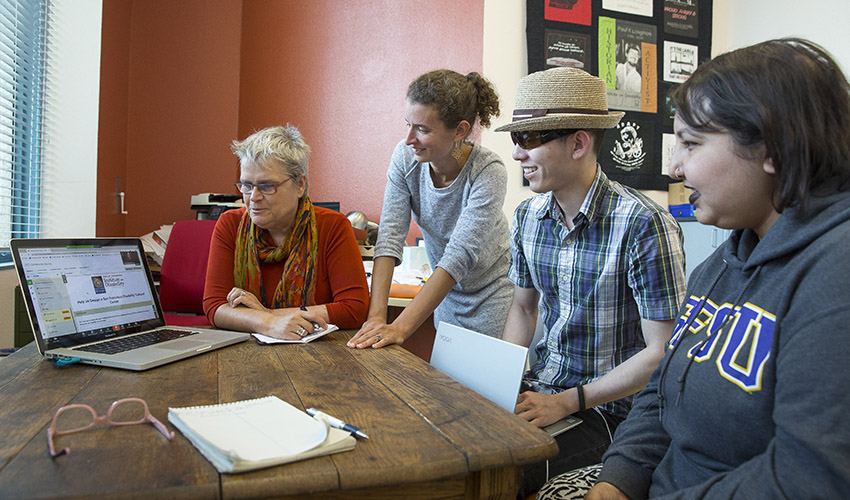University institute plans nation’s first municipal disability cultural center

(From far right) Juhee Joshi, Danny Thomas Vang, Emily Beitiks and Catherine Kudlick hold a planning meeting regarding the city’s future Disability Cultural Center.
SF State’s Paul K. Longmore Institute on Disability is working with the city to make the center a reality
San Francisco has a lot of unique cultural centers. There’s the Asian Pacific Islander Cultural Center, the United Irish Cultural Center, the Chinese Culture Center, the Croatian American Cultural Center and many more. What San Francisco doesn’t have — because no city in the nation has one — is a disability cultural center.
That’s about to change thanks to San Francisco State University’s Paul K. Longmore Institute on Disability. Founded to showcase the experiences of people with disabilities and to change perceptions about people with disabilities, the Institute is spearheading development of the center after winning a $100,000 bid from the city’s Department of Aging and Adult Services (DAAS). The effort will be underwritten by the Dignity Fund, a voter-approved initiative that requires the city to apportion a percentage of its budget to DAAS for the benefit of older adults and adults with disabilities.
“San Francisco needs a place where people can engage with disability culture,” said San Francisco State Professor of History Catherine Kudlick, the Longmore Institute’s director. “No other city as far as we can tell has a disability cultural center, so this will be a trailblazer.”
DAAS Executive Director Shireen McSpadden said the Institute has the historical knowledge and the expertise around working with people with various disabilities. “What we’ve been struggling with as a community is to provide a cultural experience that works for people living with disabilities in San Francisco and this center, under the guidance of the Longmore Institute, will do that,” she said.
Emily Beitiks, the Institute’s assistant director, and SF State senior Danny Thomas Vang, a fellow with the Institute, are also helping with the planning process. Together they’ve assembled a leadership council of 12 — all people with disabilities who are either disability advocates or work with people who have disabilities in San Francisco.
“It’s important that the center is created by people with disabilities,” Kudlick said. “Traditionally, non-disabled people would be the ones making these decisions, saying, ‘Here’s what disabled people need.’ And then you as a disabled person [are expected to] feel grateful even though you weren’t consulted on the project.”
As part of their research, the SF State team visited several existing cultural centers in the city to understand what the new center could offer. “If we have a disability cultural center and it’s understood the same way these other cultural centers are understood, that’s a huge leap forward for changing perceptions of disability,” Beitiks said.
As part of their inclusive approach, the Institute is surveying members of the San Francisco disability community, asking what they’d like the center’s goals to be and what kind of programming to offer, Vang says. Later, they’ll hold focus groups to solidify their vision.
“I hope this is a place where members of the disability community can socialize as well as express themselves through the arts or technology,” Vang said. “I also want it to be a place where we start a deeper dialogue on disability culture. It’s not often seen as a culture; rather, it’s seen as a medical condition.”
Kudlick and her Longmore Institute colleagues plan to submit the final proposal and recommendations to the city by the end of April. While a location for center hasn’t been chosen, DAAS Executive Director Shireen McSpadden says she hopes it will open by late 2019.